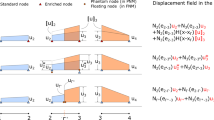Abstract
This study is part of a major research program concerning intelligent condition monitoring of aerospace composites. Specifically, it evaluates the influence of nanofillers on the reinforcement of adhesively bonded layer under mode-I fracture toughness using multiscale modelling. In this novel approach, we couple coarse–grain molecular dynamics with continuum mechanics. The molecular dynamics domain and the finite element domain are overlapped in a handshaking subdomain, The implementation of coarse–grain molecular dynamics radically reduces the size of the problem. An explicit algorithm coupling the two methodologies was developed and used to determine the energy release rates of cohesive cracks in adhesively bonded composite joints with varying amount of nano-reinforcement in the adhesive layer. Both the quality of the prediction of the multiscale model and the influence of the nanofillers are evaluated and discussed.
Similar content being viewed by others
References
Abraham F.F., Bernstein N., Broughton J.Q. and Hess D. (2000). Dynamic fracture of silicon: concurrent simulation of quantum electrons, classical atoms, and the continuum solid. MRS Bulletin 25: 27–32
Abrams C.F. and Kremer K. (2003). Combined coarse–grained and atomistic simulation of liquid bisphenol A-Polycarbonate: liquid packing and intramolecular structure. Macromolecules 36: 260–267
Allen M.P. and Tildesley D.J. (1987). Computer Simulation of Liquids. Clarendon Press, Oxford
Boss J.N., Ganesh V.K. and Lim C.T. (2003). Modulus grading versus geometrical grading of composite adherends in single-lap bonded joints. Composite Structures 62: 113–121
Cormier J., Rickman J.M. and Delph T.J. (2001). Stress calculation in atomistic simulations of perfect and imperfect solids. Journal of Applied Physics 89(1): 99–104
Doyle C., Martin A., Liu T., Wu M., Hayes S. and Crosby P.A. (1998). In-situ process and condition monitoring of advanced fibre-reinforced composite materials using optical fibre sensors. Smart Materials & Structure 7: 145–158
Forte M.S., Whitney J.M. and Schoeppner G.A. (2004). The influence of adhesive reinforcement on the Mode I fracture toughness of a bonded joint. Composites Science and Technology 60: 2389–2405
Grassi M. and Zhang X. (2003). Finite element analyses of mode I interlaminar delamination in z-fibre reinforced composite laminates. Composite Science and Technologies 63: 1815–1832
Kremer, K. and Grest, G.S. (1995). In: K. Binder (ed.), Chapter 4 in Book: Monte Carlo and Molecular Dynamics Simulation in Polymer Science, Oxford University Press, New York, pp. 194–271.
Kwon Y.W. and Jung S.H. (2004). Atomic model and coupling with continuum model for static equilibrium problems. Computer & Structures 82: 1993–2000
Liu B., Huang Y., Jiang H., Qu S. and Hwang K.C. (2004). The atomic-scale finite element method. Computer Methods in Applied Mechanics and Engineering 193: 1849–1864
Lurie S.A., Belov P.A. and Tuchkova N.P. (2005). The application of the multiscale models for description of the dispersed composites. Composites: Part A 36: 145–152
Lutsko J.F. (1988). Stress and elastic constants in anisotropic solids: molecular dynamics techniques. Journal of Applied Physics 64(3): 1152–1154
Meguid S.A. and Sun Y. (2004). On the tensile and shear strength of nano-reinforced composite interfaces. Materials & Design 25: 289–296
Naganuma T. and Kagawa Y. (2002). Effect of particle size on the optically transparent nano meter-order glass particle-dispersed epoxy matrix composites. Composites Science and Technology 62(9): 1187–1189
Odegard G.M., Gates T.S., Wise K.E., Park C. and Siochi E.J. (2003). Constitutive modelling of nanotubes-reinforced polymer composites. Composites Science and Technology 63(11): 1671–1687
Pantano A. and Averill R.C. (2004). A mesh-independent interface technology for simulation of mixed-mode delamination growth. International Journal of Solids and Structures 41: 3809–3831
Park H.S., Karpov E.G. and Liu W.K. (2004). A temperature equation for coupled atomistic/continuum simulations. Computer Method in Applied Mechanics and Engineering 193: 1713–1732
Qian D., Wagner G.J. and Liu W.K. (2002). Mechanics of carbon nanotubes. Applied Mechanics Review 55(6): 495–533
Richards W.L., Lee D.G. and Stewart A. (2004). Characterization of embedded fiber optic sensors in advanced composite materials for structural health monitoring, smart structures and materials 2004: smart structures and integrated systems. In: Flatau, Alison B. (eds) Proceedings of SPIE, Vol. 5390,, pp 505–512. SPIE, Bellingham, WA
Rudd R.E. and Broughton J.Q. (2000). Concurrent coupling of length scales in solid state system. Physical Status Solid B-Basic Research 217(1): 251–291
Shilkrot L.E, Curtin W.A. and Miller R.E. (2002). A coupled Atomistic/continuum model of defects in solids. Journal of the Mechanics and Physics of Solids 50: 2085–2106
Spoel, D.V.D., Buuren, A.R., Apol, E., Meulenhoff, P.J., Tieleman, D.P., Sijbers, A.L.T.M., Hess, B., Feenstra, K.A., Lindahl, E., Drunen, R.V. and Berendsen, H.J.C. (2002). Gromacs user manual version 3.1.1, Nijenborgh 4, 9747 AG Groningen, The Nethlelands, Internet:http://www.gromacs.org
Stewart A., Carman G. and Richards L. (2005). Health monitoring technique for composite materials utilizing embedded thermal fiber optic sensors. Journal of composite materials 39(3): 199–213
Sun, Y., Meguid, S.A., Liew, K.M. and Ong, L.S. (2004). Design and development of new nano-reinforced bonds and interfaces, In: Proceedings of Nanotech 2004, March 8–11, 2004, Boston, USA, pp. 126–129.
Author information
Authors and Affiliations
Corresponding author
Rights and permissions
About this article
Cite this article
Meguid, S.A., Sun, Y. Intelligent Condition Monitoring of Aerospace Composites: Part I - Nano Reinforced Surfaces & Interfaces. Int J Mech Mater Des 2, 183–198 (2005). https://doi.org/10.1007/s10999-005-0001-5
Received:
Accepted:
Published:
Issue Date:
DOI: https://doi.org/10.1007/s10999-005-0001-5




